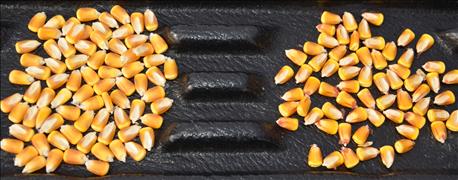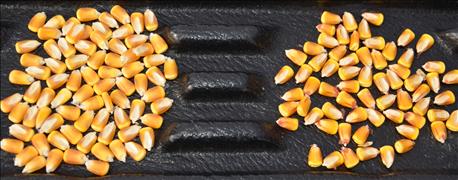
You are aware that there was some damaged kernels from ear rots when you binned your corn. You also know that certain fungi produce mycotoxins. What should you do, if anything, now that your corn is in the bin?
The Crop Protection Network provides information on a series of disease topics, including a review of the most frequently asked questions about mycotoxins produced by various fungi that cause ear rots in corn. CPN is a multistate and international collaboration of university specialists. Several Midwestern universities contribute to information posted there, including Purdue University.
Corn Illustrated 12/05: What you always wanted to know about mycotoxins and never asked
 FREE OF DISEASE: There are quality differences in these two sets of corn kernels from different hybrids. However, neither sample contains damaged kernels that might produce mycotoxins.
FREE OF DISEASE: There are quality differences in these two sets of corn kernels from different hybrids. However, neither sample contains damaged kernels that might produce mycotoxins.
Here are questions and answers related to what to do with corn that might have mycotoxin issues once it is in the bin. Find more information at cropprotectionnetwork.org.
Question: When should you test for mycotoxins in grain?
CPN: The risk of mycotoxins in harvested grain increases with the number of infected kernels on an ear. Assume that diseased kernels contain mycotoxins. However, mycotoxin levels may vary among diseased ears. Additionally, corn that appears to have a mild ear rot may still have very high mycotoxin levels. This makes the decision of whether to test for mycotoxins difficult.
The threshold before you test for aflatoxin should be low; if you found ears with aspergillus ear rot, test that grain. For DON and fumonisins, the threshold is flexible. If 30% of the ears in a field had gibberella or fusarium ear rot, test for DON and fumonisins. Also test your corn if you observed severe symptoms with more than 50% of the ear covered with mold or either disease on multiple ears.
Question: Will drying, heating, freezing or applying chemicals reduce mycotoxins in grain?
CPN: No! Mycotoxins are extremely stable. Heating, freezing, roasting or treating with chemicals can’t reliably reduce mycotoxin levels within kernels. In some cases, you can reduce the overall concentration of mycotoxins in your grain by removing fines, foreign materials and lightweight, moldy kernels.
Question: Can you reduce further accumulation of mycotoxins in stored grain?
CPN: You can greatly reduce the further accumulation of mycotoxins in stored grain by properly drying corn to less than 15% moisture. Dry grain to 13% for long-term storage.
Question: What happens if grain moisture levels in storage are 16% or more?
CPN: When grain moisture levels are greater than 16%, the risk of aflatoxin and ochratoxin accumulation increases. Aflatoxin is produced by aspergillus. Ochratoxin is produced by Penicillium verrucosum, and by some aspergillus species. A moisture level of 18% elevates the risk of DON, zearalenone and fumonisins. Warm conditions accelerate the rates of both spoilage and mycotoxin accumulation. There is no evidence that mycotoxin levels will increase in grain stored at an appropriately low moisture level.
Corn Illustrated 11/28: 10 tips to plan for the 2017 growing season
Question: So what is the take-home message for someone who has corn in the bin and is concerned there may be damaged kernels present?
CPN: It’s important to note that while high-temperature drying stops mold growth and mycotoxin production, it will not reduce the level of mycotoxin already present, as noted earlier.
Quick drying is preferred over low-heat drying. Be wary of low-temperature, in-bin dryers for moldy corn, and be sure to meet proper ventilation requirements for dry corn storage.
About the Author(s)
You May Also Like




